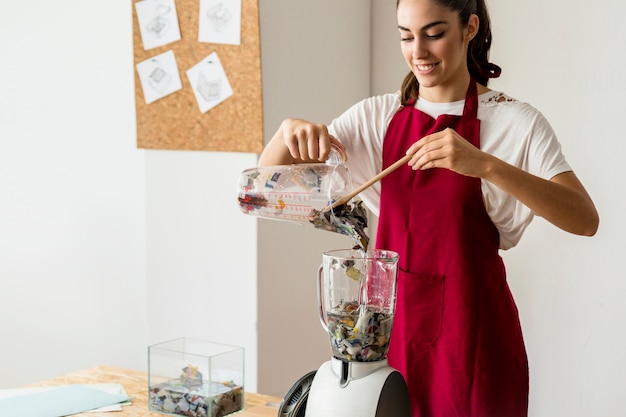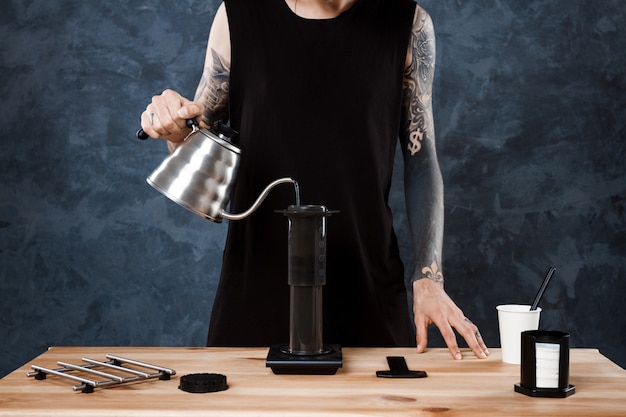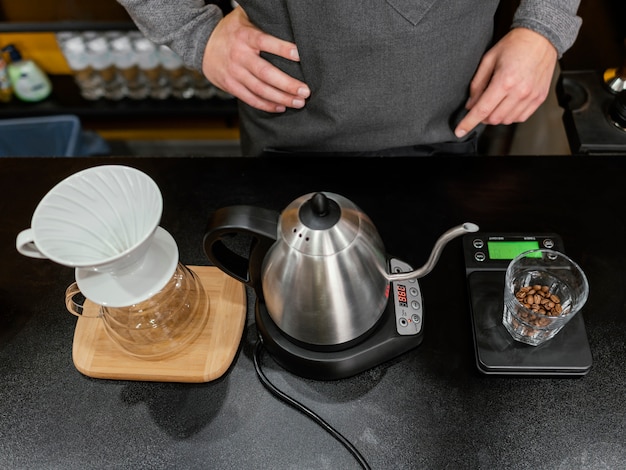For years, I've been a coffee enthusiast, always eager to explore the vast world of coffee brewing. From the classic French Press to the modern pour-over, I've tried them all. But nothing has captured my attention quite like the raw coffee brewing method. It's a journey of discovery, a balancing act between patience and precision, and a true testament to the art of coffee brewing.
This guide is for those who are curious about exploring the world of raw coffee brewing. We'll delve into the fundamentals, the various techniques, and most importantly, how long it takes to brew a perfect cup of coffee using this method. Get ready for a caffeinated adventure that will redefine your understanding of coffee!
(Part 1) Unveiling the Raw Method: A Taste of Coffee's True Essence

The raw method, also known as "unroasted" or "green coffee brewing," is a unique and intriguing approach to coffee preparation. Unlike the traditional method, which uses roasted beans, this method utilizes green, unroasted coffee beans. This means experiencing coffee in its purest form, unmasked by the process of roasting. You get to taste the beans' natural flavors and complexities, a symphony of nuances that are often lost in the roasting process.
The Raw Method: A Sensory Exploration
Imagine savoring a fruit straight from the tree, before any processing. Picture the vibrant sweetness of a ripe mango or the tartness of a cherry. That's what green coffee offers: a burst of fruity, floral, and earthy notes that are unique to the unroasted bean. It's like uncovering a secret world of flavor within the coffee bean, a world that's often hidden by the familiar aromas of roasted coffee.
The Science Behind the Raw Method
green coffee beans are packed with chlorogenic acid, a compound that contributes to the characteristic bitterness we associate with roasted coffee. During roasting, this acid breaks down, leading to the development of those beloved coffee aromas. But in the raw method, this acid remains intact, creating a unique flavour profile that's both refreshing and complex. It's a different kind of bitterness, a subtle hint of sharpness that adds depth and dimension to the overall flavor experience.
Why Embrace the Raw Method?
Beyond the extraordinary flavor experience, the raw method offers several compelling reasons to explore this brewing technique:
- A Healthier Choice: Green coffee beans are bursting with antioxidants and have been linked to potential health benefits, including improved metabolism and better blood sugar control. This makes raw coffee a healthier alternative to its roasted counterpart.
- Sustainable Coffee Production: By using unroasted beans, you're supporting more sustainable coffee farming practices. The beans don't need the energy-intensive roasting process, reducing the environmental impact of coffee production. This is a conscious choice that aligns with our growing concern for sustainability.
- A Deeper Understanding of Coffee: This method allows you to truly appreciate the nuances of coffee and its origins. You can explore the distinct flavor profiles of various coffee varieties, each with its own unique characteristics and stories. It's a journey of discovery, a chance to connect with the source of your coffee and understand the journey it took to reach your cup.
(Part 2) Preparing Your Raw Coffee: A Foundation for Flavor

Before we dive into the brewing process, it's crucial to prepare your raw coffee beans. This step sets the stage for a truly flavorful cup of coffee.
1. Sourcing High-Quality Beans: The Key to Success
Finding the right raw coffee beans is essential for a great tasting brew. You can purchase them online from specialty roasters or online retailers. However, I recommend exploring local coffee roasters who might offer green beans for brewing. They often have a deeper understanding of the beans and can provide valuable insights and recommendations. Look for reputable sources that offer high-quality, ethically sourced beans. You want beans that have been carefully cultivated and processed, ensuring a fresh and flavorful experience.
2. The Art of Grinding: Unlocking the Flavors
Freshly ground coffee is paramount for maximizing flavor. If you're using a traditional burr grinder, aim for a coarse grind, similar to the consistency of sea salt. This will allow for proper extraction and prevent over-extraction, which can lead to a bitter brew. For those who prefer the convenience of a French Press, a medium grind will work best. Remember, the grind size impacts the extraction process, so it's essential to choose the right grind for your chosen brewing method.
3. Decaffeination: A Personal Choice
For those sensitive to caffeine, decaffeination is an option. This process removes most of the caffeine while preserving the flavor profile. However, decaffeination can subtly affect the overall flavor of the coffee. Experiment with both decaffeinated and regular green coffee beans to see which best suits your preferences.
(Part 3) Unveiling the Brewing Methods: A Journey of Flavors

There are numerous brewing methods suitable for raw coffee, each offering a unique flavour experience. Each method unlocks different facets of the raw coffee beans' flavour profile, allowing you to explore a spectrum of tastes.
1. The Cold Brew Method: A Refreshing Experience
This method involves steeping coarsely ground raw coffee beans in cold water for an extended period, typically 12-24 hours. The slow extraction process results in a smooth, less acidic coffee with a slightly sweet flavour. I personally love making cold brew in the summer, as it's incredibly refreshing and perfect for iced coffee. The cold brew method is ideal for those who prefer a lighter, more subtle coffee experience.
2. The French Press Method: A Classic with a Twist
The French Press, a classic brewing method, involves steeping coarsely ground raw coffee beans in hot water for a few minutes. This method allows for a full-bodied, slightly more intense flavor compared to cold brew. It's a great option for those who enjoy a richer, more robust coffee experience. The French Press method is known for its full-bodied flavor and ease of use.
3. The Pour-Over Method: Precision and Elegance
The pour-over method uses a filter cone to brew coffee, allowing for precise control over the water flow and extraction time. This method produces a clean, bright cup of coffee with a delicate flavor, showcasing the subtle nuances of the raw coffee beans. It's an excellent choice for those who appreciate a more nuanced and refined coffee experience. The pour-over method is known for its clarity of flavor and its ability to highlight the delicate nuances of raw coffee.
4. The raw coffee drip Method: Simplicity and Convenience
Similar to the pour-over method, the raw coffee drip method uses a traditional drip coffee maker. This method allows for a larger batch of raw coffee and is a great option for those who enjoy a quick and easy brewing process. For me, it's a simple way to enjoy a refreshing cup of raw coffee on a busy morning. The drip method is a convenient way to brew a larger quantity of raw coffee.
(Part 4) The Essential Question: How Long to Brew Raw Coffee?
Now, let's tackle the question that's been on your mind: how long does it take to brew raw coffee? The answer, like everything in the world of coffee, is nuanced and depends on the brewing method you choose.
1. Cold Brew: A Symphony of Time and Flavor
The cold brew method requires patience, but the wait is truly worth it. Steep coarsely ground raw coffee beans in cold water for 12-24 hours, depending on your desired strength. The longer you steep, the stronger and more intense the coffee will become. The cold brew method is a testament to the power of slow extraction, resulting in a smooth, flavorful brew.
2. French Press: A Balance of Speed and Intensity
For the French Press, steep coarsely ground raw coffee beans in hot water for 3-5 minutes. This method is much quicker, offering a convenient way to enjoy a rich cup of raw coffee. The French Press method offers a quick and easy way to enjoy a full-bodied raw coffee experience.
3. Pour-Over: A Dance of Precision and Time
The pour-over method requires a more delicate touch. Pour hot water over the ground raw coffee beans in a filter cone, allowing the water to drip through slowly for 2-4 minutes. The extraction time depends on the grind size and the desired strength. The pour-over method allows for precise control over the extraction process, resulting in a clean and flavorful brew.
4. Raw Coffee Drip: Simplicity and Efficiency
The raw coffee drip method is similar to the pour-over, but using a drip coffee maker. This method typically takes 5-8 minutes, depending on the size of your coffee pot. The drip method is a convenient way to brew a larger quantity of raw coffee quickly and efficiently.
(Part 5) Fine-Tuning Your Brew: Mastering the Art of Coffee
Brewing raw coffee is an art form. Mastering the perfect cup takes practice and experimentation. The following factors are key to crafting a truly exquisite cup of raw coffee.
1. Grind Size: The Key to Flavor Release
The grind size plays a crucial role in extraction. A coarser grind results in a weaker brew, while a finer grind produces a stronger cup. Experiment with different grind sizes to find the perfect balance for your taste. The grind size affects the surface area of the coffee grounds, impacting how quickly and thoroughly the water can extract the flavors.
2. water temperature: Finding the Ideal Balance
Unlike roasted coffee, raw coffee can withstand higher water temperatures. While it's not recommended to use boiling water, aim for a temperature between 180°F (82°C) and 200°F (93°C). This range helps extract the flavors without scorching the beans. Water temperature is a crucial factor in extraction, influencing the extraction of different flavor compounds. Too hot, and you risk bitterness; too cold, and the extraction will be incomplete.
3. Water Ratio: Crafting the Perfect Strength
The water ratio determines the strength of your brew. The general rule of thumb is to use a 1:16 ratio (1 gram of coffee to 16 grams of water). Adjust this ratio based on your preference for a stronger or weaker brew. The water ratio directly impacts the concentration of flavor in your cup. A higher ratio (more water) will result in a weaker brew, while a lower ratio (less water) will produce a stronger cup.
4. Brewing Time: The Art of Extraction
The brewing time also influences the flavor profile. A longer brewing time will result in a more extracted, bold flavor. Experiment with different brewing times to discover what suits your taste buds. Brewing time impacts the amount of flavor compounds extracted from the coffee grounds. A longer brewing time can lead to a more intense and full-bodied flavor, but it can also increase bitterness if not managed correctly.
(Part 6) The Unforgettable Flavors of Raw Coffee: A Sensory Journey
The flavour profile of raw coffee is a revelation. It's a world of vibrant acidity, fruity notes, and earthy undertones, a symphony of flavors that's unlike anything you've experienced before.
1. The Natural Acidity: A Refreshing Burst
Raw coffee boasts a natural acidity that's refreshing and vibrant, often described as citrusy, floral, or even berry-like. This acidity provides a bright and lively character to the brew. The acidity in raw coffee is a testament to its unroasted state, preserving the natural acidity of the coffee cherry.
2. Fruity Notes: A Tropical Delight
The unroasted beans retain the natural fruitiness of the coffee cherry. This translates to delightful notes of mango, berries, or even tropical fruits like passionfruit and guava. The fruity notes in raw coffee are a direct reflection of the origin of the bean and the unique characteristics of the coffee variety.
3. Earthy Undertones: Depth and Complexity
The earthy notes of raw coffee are subtle and complex, adding depth and complexity to the flavour profile. These notes can range from chocolate and nuts to vegetal notes like spinach or even a hint of mushroom. The earthy notes in raw coffee are a result of the bean's natural composition and the terroir where it was grown, adding a unique layer of flavor to the brew.
(Part 7) Beyond the Cup: Exploring Raw Coffee's Culinary Potential
Raw coffee is not limited to brewing. Its unique properties open up a world of culinary possibilities, adding a touch of coffee's unique flavor to your dishes and drinks.
1. Raw Coffee Cocktails: A Refreshing Twist
The refreshing acidity and fruitiness of raw coffee make it a fantastic base for cocktails. Experiment with different combinations, incorporating citrus fruits, herbs, and even spices to create unique and invigorating drinks. Raw coffee's vibrant acidity and fruity notes make it a perfect ingredient for cocktails, adding a distinctive flavor dimension.
2. Raw Coffee Desserts: A Touch of Coffee Elegance
The subtle earthy notes of raw coffee can be used to enhance desserts. Add ground raw coffee beans to chocolate cakes, brownies, or even ice cream for an unexpected flavour twist. Raw coffee's earthy notes provide a subtle but distinct flavor profile that complements the sweetness of desserts.
3. Raw Coffee Marinades: A Flavorful Enhancement
The natural acidity of raw coffee makes it a great marinade for meat and poultry. It helps tenderize the meat and adds a unique flavour dimension. Raw coffee's acidity works as a natural tenderizer, enhancing the flavor of meat and poultry while adding a unique coffee aroma.
(Part 8) FAQs: Unraveling the Mysteries of Raw Coffee
Here are some frequently asked questions about raw coffee brewing:
1. Is raw coffee safe to drink?
Yes, raw coffee is safe to drink. The beans are thoroughly washed and processed before being sold, ensuring they're free from harmful contaminants. However, it's important to purchase beans from reputable sources to ensure quality and safety. When purchasing raw coffee, always choose reputable sources that prioritize quality and safety standards.
2. Does raw coffee have caffeine?
Yes, raw coffee contains caffeine, although the amount can vary depending on the variety and roasting level. If you're sensitive to caffeine, you can choose decaffeinated green coffee beans. Raw coffee beans contain caffeine naturally, but the amount can vary depending on the coffee variety and the decaffeination process (if applicable).
3. Can I roast raw coffee beans at home?
Yes, you can roast raw coffee beans at home using a home roaster. This allows for greater control over the roasting process and a more personalized experience. However, it requires some investment and practice to achieve the desired results. Home roasting requires careful monitoring and adjustments to achieve the desired level of roast and flavor profile.
4. What are the benefits of drinking raw coffee?
Raw coffee is packed with antioxidants and other beneficial compounds. It's also naturally less acidic than roasted coffee, making it easier to digest for some people. However, it's important to note that these benefits are still under investigation and may vary depending on the individual. The potential health benefits of raw coffee are still being researched, but it's recognized for its antioxidant content and lower acidity compared to roasted coffee.
5. How long does raw coffee last?
Raw coffee beans can last for several months if stored properly in an airtight container in a cool, dark place. However, the flavor will gradually decline over time, so it's best to use them within a few months for the best results. Proper storage is crucial for preserving the freshness and flavor of raw coffee beans.
(Part 9) Conclusion: A Journey of Discovery and Flavor
Embarking on the journey of raw coffee brewing is like stepping into a new world of flavor and exploration. It's a chance to appreciate coffee in its purest form, unhindered by the complexities of roasting. This guide has provided a starting point for your own raw coffee adventures. Remember, the key is to experiment, discover your preferences, and enjoy the unique and captivating world of raw coffee.
Everyone is watching

Corn on the Cob: The Ultimate Guide to Perfectly Cooked Ears
Healthy MealsAh, corn on the cob. Just the name evokes images of sunny days, barbecues, and that sweet, juicy flavour that ...

Perfect Pork Roast Oven Cooking Time: A Guide to Delicious Results
Healthy MealsThere's something truly satisfying about a perfectly roasted pork. The aroma alone is enough to make your mout...

Ham Cooking Time: How Long to Bake, Smoke, or Boil a Delicious Ham
Healthy MealsAh, ham. It's a classic, isn't it? A real crowd-pleaser, especially around holidays. And when done right, it'...

Scallops: The Ultimate Guide to Perfect Cooking
Healthy MealsAh, scallops. Those delicate, sweet, and utterly delicious morsels of the sea. They hold a special place in my...

Spaghetti Squash: The Ultimate Guide to Cooking and Serving
Healthy MealsRemember that time you saw spaghetti squash at the supermarket, looking all bumpy and strange, and thought, "W...
